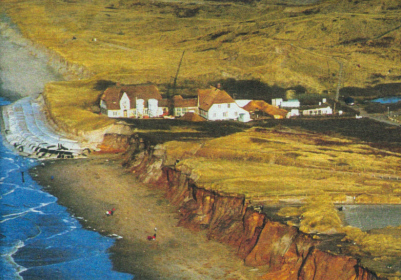|
Watertable Control
Watertable control is the practice of controlling the height of the water table by drainage. Its main applications are in agricultural land (to improve the crop yield using agricultural drainage systems) and in cities to manage the extensive underground infrastructure that includes the foundations of large buildings, underground transit systems, and extensive utilities (water supply networks, sewerage, storm drains, and underground electrical grids). Description and definitions Subsurface land drainage aims at controlling the water table of the groundwater in originally waterlogged land at a depth acceptable for the purpose for which the land is used. The depth of the water table with drainage is ''greater'' than without. Purpose In agricultural land drainage, the purpose of water table control is to establish a depth of the water table (Figure 1) that does no longer interfere negatively with the necessary farm operations and crop yields (Figure 2, made with the SegReg mode ... [...More Info...] [...Related Items...] OR: [Wikipedia] [Google] [Baidu] |
Water Table
The water table is the upper surface of the zone of saturation. The zone of saturation is where the pores and fractures of the ground are saturated with water. It can also be simply explained as the depth below which the ground is saturated. The water table is the surface where the water pressure head is equal to the atmospheric pressure (where gauge pressure = 0). It may be visualized as the "surface" of the subsurface materials that are saturated with groundwater in a given vicinity. The groundwater may be from precipitation or from groundwater flowing into the aquifer. In areas with sufficient precipitation, water infiltrates through pore spaces in the soil, passing through the unsaturated zone. At increasing depths, water fills in more of the pore spaces in the soils, until a zone of saturation is reached. Below the water table, in the phreatic zone (zone of saturation), layers of permeable rock that yield groundwater are called aquifers. In less permeable soils, such as ... [...More Info...] [...Related Items...] OR: [Wikipedia] [Google] [Baidu] |
SegReg
In statistics and data analysis, the application software SegReg is a free and user-friendly tool for linear segmented regression Segmented regression, also known as piecewise regression or broken-stick regression, is a method in regression analysis in which the independent variable is partitioned into intervals and a separate line segment is fit to each interval. Segmented r ... analysis to determine the breakpoint where the relation between the dependent variable and the independent variable changes abruptly. Features SegReg permits the introduction of one or two independent variables. When two variables are used, it first determines the relation between the dependent variable and the most influential independent variable, where after it finds the relation between the residuals and the second independent variable. Residuals are the deviations of observed values of the dependent variable from the values obtained by segmented regression on the first independent variable. The ... [...More Info...] [...Related Items...] OR: [Wikipedia] [Google] [Baidu] |
Geotextile
Geotextiles are permeable fabrics which, when used in association with soil, have the ability to separate, filter, reinforce, protect, or drain. Typically made from polypropylene or polyester, geotextile fabrics come in two basic forms: woven (resembling mail bag sacking) and nonwoven (resembling felt). Geotextile composites have been introduced and products such as geogrids and meshes have been developed. Geotextiles are durable and are able to soften a fall. Overall, these materials are referred to as geosynthetics and each configuration—geonets, geosynthetic clay liners, geogrids, geotextile tubes, and others—can yield benefits in geotechnical and environmental engineering design. History Geotextiles were originally intended to be a substitute for granular soil filters. The original, and still sometimes used, term for geotextiles is ''filter fabrics''. Work originally began in the 1950s with R.J. Barrett using geotextiles behind precast concrete seawalls, under precast c ... [...More Info...] [...Related Items...] OR: [Wikipedia] [Google] [Baidu] |
Synthetic Fibre
Synthetic fibers or synthetic fibres (in British English; see spelling differences) are fibers made by humans through chemical synthesis, as opposed to natural fibers that are directly derived from living organisms, such as plants (like cotton) or fur from animals. They are the result of extensive research by scientists to replicate naturally occurring animal and plant fibers. In general, synthetic fibers are created by extruding fiber-forming materials through spinnerets, forming a fiber. These are called synthetic or artificial fibers. The word polymer comes from a Greek prefix "poly" which means "many" and suffix "mer" which means "single units". (Note: each single unit of a polymer is called a monomer). Early experiments The first fully synthetic fiber was glass. Joseph Swan invented one of the first artificial fibers in the early 1880s; today it would be called semisynthetic in precise usage. His fiber was drawn from a cellulose liquid, formed by chemically modifying th ... [...More Info...] [...Related Items...] OR: [Wikipedia] [Google] [Baidu] |
Trenching Machine
A trencher is a piece of construction equipment used to dig trenches, especially for laying pipes or electrical cables, for installing drainage, or in preparation for trench warfare. Trenchers may range in size from walk-behind models, to attachments for a skid loader or tractor, to very heavy tracked heavy equipment. Types Trenchers come in different sizes and may use different digging implements, depending on the required width and depth of the trench and the hardness of the surface to be cut. Wheel trencher A wheel trencher or rockwheel is composed of a toothed metal wheel. It is cheaper to operate and maintain than chain-type trenchers. It can work in hard or soft soils, either homogeneous (compact rocks, silts, sands) or heterogeneous (split or broken rock, alluvia, moraines). This is particularly true because a cutting wheel works by clearing the soil as a bucket-wheel does, rather than like a rasp (chain trencher). Consequently, it will be less sensitive to the presenc ... [...More Info...] [...Related Items...] OR: [Wikipedia] [Google] [Baidu] |
Polyethylene
Polyethylene or polythene (abbreviated PE; IUPAC name polyethene or poly(methylene)) is the most commonly produced plastic. It is a polymer, primarily used for packaging ( plastic bags, plastic films, geomembranes and containers including bottles, etc.). , over 100 million tonnes of polyethylene resins are being produced annually, accounting for 34% of the total plastics market. Many kinds of polyethylene are known, with most having the chemical formula (C2H4)''n''. PE is usually a mixture of similar polymers of ethylene, with various values of ''n''. It can be ''low-density'' or ''high-density'': low-density polyethylene is extruded using high pressure () and high temperature (), while high-density polyethylene is extruded using low pressure () and low temperature (). Polyethylene is usually thermoplastic, but it can be modified to become thermosetting instead, for example, in cross-linked polyethylene. History Polyethylene was first synthesized by the German chemist Hans ... [...More Info...] [...Related Items...] OR: [Wikipedia] [Google] [Baidu] |
Plastic
Plastics are a wide range of synthetic or semi-synthetic materials that use polymers as a main ingredient. Their plasticity makes it possible for plastics to be moulded, extruded or pressed into solid objects of various shapes. This adaptability, plus a wide range of other properties, such as being lightweight, durable, flexible, and inexpensive to produce, has led to its widespread use. Plastics typically are made through human industrial systems. Most modern plastics are derived from fossil fuel-based chemicals like natural gas or petroleum; however, recent industrial methods use variants made from renewable materials, such as corn or cotton derivatives. 9.2 billion tonnes of plastic are estimated to have been made between 1950 and 2017. More than half this plastic has been produced since 2004. In 2020, 400 million tonnes of plastic were produced. If global trends on plastic demand continue, it is estimated that by 2050 annual global plastic production will reach over 1, ... [...More Info...] [...Related Items...] OR: [Wikipedia] [Google] [Baidu] |
Tile Drainage
Tile drainage is a form of agricultural drainage system that removes excess sub-surface water from fields to allow sufficient air space within the soil, proper cultivation, and access by heavy machinery to tend and harvest crops. While surface water can be drained by pumping, open ditches, or both, tile drainage is often the most effective means of draining subsurface water. The phrase "tile drainage" derives from its original composition from ceramic tiles of fired clay, which were similar to terracotta pipes yet not always shaped as pipes. In the 19th century a "C" shaped channel tile commonly was placed like an arch atop a flat tile, denominated the "mug" and "sole", respectively. Today, tile drainage is any variation of this original system that functions in the same mode. Commonly HDPE and PVC tubing denominated "tile line" is used, although precast concrete and ceramic tiles are still used. Typical pathways for agricultural drainage and the occasionally used pathways for tr ... [...More Info...] [...Related Items...] OR: [Wikipedia] [Google] [Baidu] |
SaltMod
SaltMod is computer program for the prediction of the salinity of soil moisture, groundwater and drainage water, the depth of the watertable, and the drain discharge (hydrology) in irrigated agricultural lands, using different (geo)hydrologic conditions, varying water management options, including the use of ground water for irrigation, and several cropping rotation schedules. The water management options include irrigation, drainage, and the use of subsurface drainage water from pipe drains, ditches or wells for irrigation. Soil salinity models The majority of the computer models available for water and solute transport in the soil (e.g. Swatre, DrainMod ) are based on Richard's differential equation for the movement of water in unsaturated soil in combination with a differential salinity dispersion equation. The models require input of soil characteristics like the relation between unsaturated soil moisture content, water tension, hydraulic conductivity and dispersivity. Th ... [...More Info...] [...Related Items...] OR: [Wikipedia] [Google] [Baidu] |
Drainage Research
Drainage research is the study of agricultural drainage systems and their effects to arrive at optimal system design. Aspects to be covered Agricultural land drainage has agricultural, environmental, hydrological, engineering, economical, social and socio-political aspects (Figure 1). All these aspects can be subject of drainage research. The aim (objective, target) of agricultural land drainage is the optimized agricultural production related to: # reclamation of agricultural land # conservation of agricultural land # optimization of crop yield # crop diversification # cropping intensification # optimization of farm operations. Systems analysis The role of targets, criterion, environmental, and hydrological factors is illustrated in Figure 2. In this figure criterion factors are factors influenced by drainage on the one hand and the agricultural performance on the other. An example of a criterion factor is the depth of the water table: # A drainage system influences this de ... [...More Info...] [...Related Items...] OR: [Wikipedia] [Google] [Baidu] |







